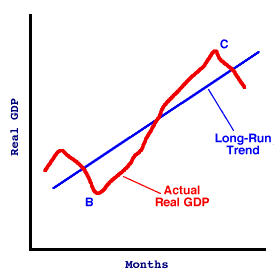
|
|
HERFINDAHL-HIRSHMAN INDEX: A measure of concentration of the production in an industry that's calculated as the sum of the squares of market shares for each firm. This is an alternative method of summarizing the degree to which an industry is oligopolistic and the relative concentration of market power held by the largest firms in the industry. The Herfindahl index gives a better indication of the relative market control of the largest firms than can be found with the four-firm and eight-firm concentration ratios.
Visit the GLOSS*arama
|
|


|

|
                           PEAK: The transition of a business-cycle expansion to a business-cycle contraction. The end of an expansion carries this descriptive term of peak, or the highest level of economic reached in recent times. A peak is one of two turning points. The other, the transition from contraction to expansion, is a trough. Turning points are important because they represent the transition from bad to good or good to bad. A business-cycle peak means the economy has reached the highest level of production in recent times. Unfortunately, because a peak is a turning point, it means that a contraction is beginning. Even though a peak is the "highest," this is not something that the economy actually wants. Ideally, a peak is never reached and the economy continues to expand.A Graphical Pinnacle| The Highest Turning Point |  |
The diagram at the right presents a simple business cycle. The red line represents the value of real gross domestic product (real GDP) over a period of several months. The blue line is potential real GDP, the amount of real GDP that the economy can produce by fully employing all resources. A business-cycle expansion is indicated as the increase in real GDP from point B to point C.While expansions are generally good, unfortunately they do not last forever. At least none have so far. There is always hope that the "current" expansion will not end. And people sometimes euphorically think that it will not. But so far every expansion, save for the "current" one, has ended. A click of the [Peak] button highlights the business cycle peak at point C which ends the expansion displayed here. A Bit of Inflation?If the peak of a business cycle lies above the long-run trend, the prospect of higher inflation emerges. Because the long-run trend represents full employment, when real GDP exceeds the potential real GDP, then the economy is trying to produce more than it can sustain in the long run. The result is higher prices and inflation. Inflation tends to be most pronounced near the peak. In fact, rising inflationary pressures often contribute to the end of the expansion and the onset of a contraction, especially if the government sector fights inflation with contractionary stabilization policies.Tracking the NumbersLike other aspects of business cycles, a peak is officially identified by the official business-cycle watchers at the National Bureau of Economic Research. Inevitably an official peak is only officially designated a year or two after the fact, once all of the relevant data have been processed and analyzed.While knowing when a peak did occur is useful information, anticipating when one will occur is even better. Knowing when the current expansion will end and the next contraction will begin makes it possible to plan for the ensuing bad times. Workers, especially those most likely to be unemployed, can be helped by anticipating a peak. So too can businesses that are seeking to avoid lost profits or even bankruptcy. Forecasting a peak is perhaps most useful for government leaders who can implement timely policies that might actually avoid the peak and ensuing contraction entirely. Forecasting upcoming peaks is commonly attempted using leading economic indicators, a series of ten economic statistics that tend to reach their "peak" three to twelve months before the actual business cycle. More sophisticated forecasts are also provided by complex mathematical models of the economy.

Recommended Citation:PEAK, AmosWEB Encyclonomic WEB*pedia, http://www.AmosWEB.com, AmosWEB LLC, 2000-2025. [Accessed: July 18, 2025].
Check Out These Related Terms... | | | | | | | | | |
Or For A Little Background... | | | | | | | | |
And For Further Study... | | | | | | | | |
Related Websites (Will Open in New Window)... | | |
Search Again?
Back to the WEB*pedia
|



|

|
PINK FADFLY
[What's This?]
Today, you are likely to spend a great deal of time calling an endless list of 800 numbers wanting to buy either a weathervane with a cow on top or a box of multi-colored, plastic paper clips. Be on the lookout for high interest rates.
Your Complete Scope
This isn't me! What am I?
|

|
|
Lombard Street is London's equivalent of New York's Wall Street.
|

|
|
"A winner is someone who recognizes his God-given talents, works his tail off to develop them into skills, and uses those skills to accomplish his goals. " -- Larry Bird, basketball player
|

|
IDA
International Development Association
|

|
|
Tell us what you think about AmosWEB. Like what you see? Have suggestions for improvements? Let us know. Click the User Feedback link.
User Feedback
|


|


